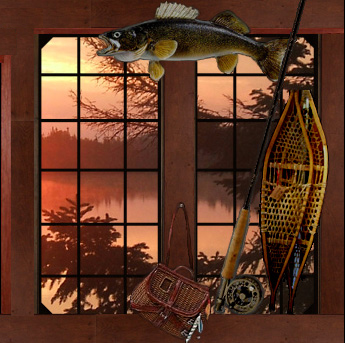|
|
Fishing the Protected Bays of
Trout Lake
By Jim Brauker
|
|
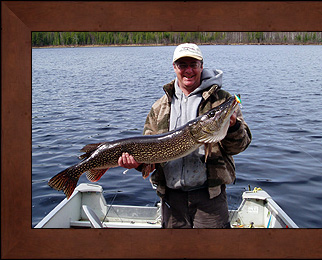
|
|
Forward
This brief article is aimed at simplifying the seemingly daunting task of finding fish in a body of water consisting of 100,000 acres. Iím a professional scientist, not a professional fisherman. As a scientist, I have learned that most of the problems I face are too difficult to comprehend unless I simplify the problem. I do this by narrowing my focus. This method of keeping it simple seems to work for finding fish as well. Here I focus on spring fishing on a huge body of water. There are two simplification tricks I use to successfully find fish in such big water. First I find the warmest water in the lake. In the spring, that means bays that are protected from wind and weather (reduction from 100,000 acres to maybe 5,000 acres). Second, I look for the warmest water in the bay. That means paying attention to wind, current, and sunlight (reduction from 5000 acres to 500-1000 acres). By narrowing the search to only a few hundred acres, what seemed daunting becomes relatively simple. You might have noticed my two tricks for finding fish are really only one, temperature. Or, as in real estate, you might say there are three tricks; temperature, temperature, and temperature.
Over the years I have been taught by many fishermen. I have learned that sharing knowledge is more productive to increasing my fishing skills than keeping secrets. The reason is that whenever I share a hot spot or technique, the recipient always seems to return the favor at a later date, often with some bit of information I never would have come up with on my own. That is the spirit of my little discussion about temperature. I hope it will lead to other discussions and am open to hearing from anyone who has thoughts and feedback. jbrauker@san.rr.com
Fishing the Protected Bays of Trout Lake
Trout Lake is an 86,000 acre lake (100,000 acres including Otter and Little Trout). In the spring, from mid-May well into June, a huge percentage of the walleyes are concentrated in a few protected bays with lots of shallow, dark, weedy water. Being adept at reading the bays, and finding the walleyes in them are important skills during early spring. While making up only a small part of the lake, these bays are major walleye factories in the spring. It is in these bays, from mid-May through mid-June, that the vast majority of walleyes are caught. The main property that distinguishes these "protected" bays from other bays in the lake is that they are cut off from direct mixing of water with the main lake in some manner. For example, Poplar Bay, H-Bay, Long Channel, and Jackfish Bay all have rather narrow openings. Keesic Bay and Long Channel both have islands that block the direct impact of weather and currents from the main lake. When storms or strong winds roil the waters of the main lake, these protected bays maintain their own water conditions that are distinct from that of the main lake. In contrast, bays like Pichaakon (Pecker) Bay, Joeís Big Rock Bay, and most of the other bays opening into the main lake are open to the deep waters of the main lake, therefore the water in these bays is not much different from that of the main lake.
The main distinctions of these bays are four. First, the temperatures are warmer in the spring than temperatures on the main lake. Second, the water is much darker in all of these bays. Third, even in the early spring, these bays are already producing new growth of weeds. Where there are green weeds, there will be walleyes. Fourth, the size of the bays is conducive to rapid formation of temperature zones and gradients, which concentrates walleyes in particular locations on the bay.
General approaches to fishing all the protected bays. First and foremost, find the warm water. Temperature is affected by solar heating, water depth, air temperature, current and wind. You do not really need a thermometer to find the warm water, but it can help. There are plenty of other clues. In the spring, the warm water is shallow. It is generally a waste of time to fish deeper than 15 feet in the spring. In fact, the great majority of the walleyes will be found in 8 feet of water or less, whetHer in a bay, on a point or even in the main lake.
Calm conditions. Calm conditions can make fishing on the main lake considerably more difficult. But, in the shallow, dark waters of the bays, calm waters can be an advantage at times and lead to wonderful, pleasant days of catching fish. In calm conditions, the main influence on temperature is the warming of the shallows. These waters are dark. Throughout the day, if the sun is shining, the shallows will rapidly warm. Walleyes will move as shallow as possible into these warm waters. Light is a main factor contributing to what I call the catch line, or the depth at which I start fishing for walleyes in the bay. The catch line is 1-2 feet deeper than I can easily see bottom. If I can see bottom in 4 feet of water, the catch line will be at 5-6 feet. If the bottom is visible in 2 feet of water, the catch line will be at 3-4 feet. Typically, fish may be cacheable for an additional 2-4 feet deeper than the catch line. For example, if the catch line is 6 feet, I may expect to catch fish out to as deep as 8-10 feet, although the closer I stay to the catch line, the faster the action I can expect.
In calm conditions, the affect of natural currents is much more pronounced than in windy conditions. For example, a portion of a bay with warm water flowing in from a creek will be more likely to hold walleyes than a distant portion of the bay. Keep in mind though, that the outflow of the warm water may create warm zones for some distance into the bay, and may follow unexpected contours of bottom and weed structure that you cannot see. Try to imagine where the stream of warm water might go as it comes into the bay (it may help to look at the map of Keesic Bay below). If there is an island nearby, what direction might the flow take? It is critical to understand where the band of warm water extends to. A second major impact is that of a cold water inlet. Many of the creeks on Trout lake feature cold water inlets. You can generally tell a cold water creek from a warm water creek without using a thermometer, just by looking at a map. The key element in a warm water creek is that there is a shallow lake feeding the creek before it enters the bay. These lakes act as warming reservoir to heat up the water before it moves into the bay. Unfortunately, because of dense brush and beaver dams, most of these lakes themselves are not accessible by boat from Trout Lake, but they have a major impact on the lake nonetheless.
So, in scoping out a bay, I start near warm water creeks, and avoid cold water creeks. While this is a good rule of thumb on calm days, it may not be as important on windy days. On windy days, because these creeks are so small, the wind may conquer the creek when it comes to temperature affects.
Calm conditions have the added advantage that it is easy to see into the water, and to fish into the weeds. On windy days with the boat shifting it is more difficult to fish the weeds. On a calm day, you can drop a jig into the weeds and have a lot more chance of hooking a walleye than by skirting the edges of the weeds. I get excited when I see weeds, especially if they are at or near the catch line. There is a tendency among fisherman to avoid throwing their line into weeds because the line may get tangled in the weeds. While this is true, there is a greater sacrifice in avoiding the weeds in that you will almost certainly catch fewer fish.
|
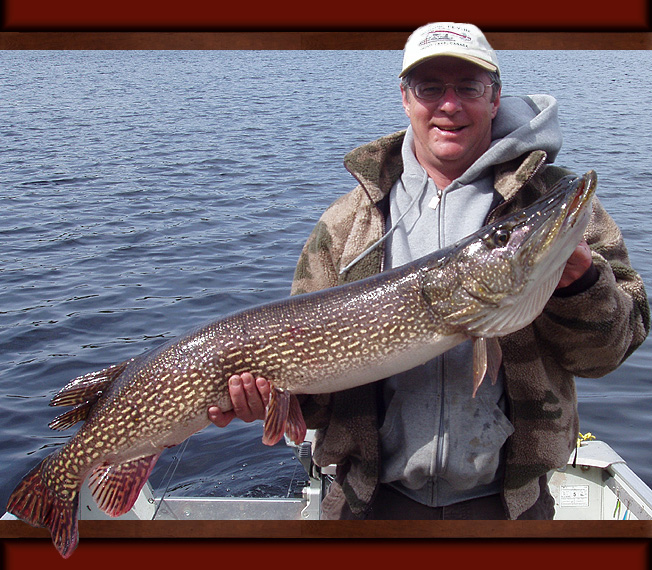
|
Please Note: The two Pike pictures above are two different Pike.
FISHING SKILLS! This brings up one of the key reasons to learn to become a good jig fisherman. So many fishermen in Canada limit their possibilities by an overdependence on trolling. Trolling is the number one means I use to find walleyes, but jigging is the number one means to catch them. The reason for this is that the jig can be placed precisely and exactly where you want to place it. You can drop it beside or between weeds, and you can do so repeatedly until you entice the fish to bite. You can try one size, type, or color of jig without a bite, and follow immediately in exactly the same spot, next to exactly the same rock, going after exactly the same fish. You donít need to maneuver your boat back around in a circle to re-present the bait. This important method makes the difference between a 100 fish day and a 25 fish day.
Windy days. When entering a bay on a windy day, one is tempted to seek refuge in the beautiful flat calm lee water found on the windward side of the bay. Instead, itís a good idea to pull your windbreaker on, pull your hat over your ears, and head for the spot where the biggest waves are hitting the shore. It takes little time after a brisk wind starts up for the warm water near the surface to get pushed to the windy side of the bay. A brisk wind can produce a 4-6įF temperature gradient across the bay, and completely dominate the location of the fish on that day.
LOGBOOK. May 19-20, 2004. Keesic Bay. On the 19th my friend Paul Valint and I caught over 100 walleyes between 1 pm and 5 pm. This was an astounding day during which we caught an estimated 20 fish over 5 lbs. We expected and usually got a hit every cast. We were not alone. Everyone in the bay was catching fish at a comparable rate. The water temperature was 45-47įF all through Mary Deeís Nest and all along the North shore to Hillbilly Island (see map below). The water temperature throughout the big lake was 32-35įF! That night, a major cold front came through. We returned in the morning to find a north wind, and that the water temperature was 34įF throughout the region we had been fishing the day before. The fish were far more difficult to catch, and much more restricted in their distribution (as well as being generally smaller) than the day before. We did catch fish though, by drifting with the north wind from 8 into 4 feet of water on the south shore of Mary Deeís Nest. Here the water temperature gradually got higher until it hit 42įF in about 4 feet of water, where the reeds start. Whatever warm surface water there was in the bay had been pushed into this region by the north wind. We kept an exact record of our walleyes that day, and stopped at about 6 pm with exactly 100 fish, 90 of which were over 18 in., and the largest being exactly 7 lbs. And 29 in. long. With 2 hours off for lunch, we spent about 7 hrs fishing. These were miserable conditions, but we still managed 100 fish (14 fish per hour, or about 1 fish every 4 minutes) by sticking closely to the only warm spot we could find in the bay. This is a striking example of how wind can concentrate fish, and fish can be found and caught even in the most extreme conditions.
When a brisk wind creates a temperature gradient in a bay, fishing can be fast and furious. Fish can be found in as little as two feet of water right up next to the shore. Expect to be casting your jig right up into the reeds that may line the shore. This is an impossible place to troll into, so you will have to get proficient at casting a jig. However, it is possible to float into those locations, with a jig hanging under or just behind the boat. It is a real pleasure to hook a walleye that is directly under the boat in 2 feet of water, and this is not a rare event when you try it. It is though, rare for people to try it, because of the long enduring myths about where walleyes should be found.
Finding walleyes in a protected bay. As I pull into the bay, I quickly scout the conditions. Where is the wind coming from, or more importantly going to? Are there boats in the bay and if so, are they catching fish? If so, things are a bit easier. Is the wind dominating or is it more likely to be the current? Based on all considerations, I quickly motor to the place where I think the warmest water may be found on that day. I will usually begin by trolling.
Prospecting. We will be covering a lot of water to start with, because we will be prospecting for fish. In the weedy areas of shallow bays, my favorite trolling lure is a number 5 shad rap in perch, fire tiger, or silver color. My partner will use a different color than me, or perhaps choose her favorite lure, perhaps a more shallow running Rapala. This may be an issue of weed tolerance. I am highly weed tolerant. I like to get down into the weeds a bit, and am willing to spend a little more time getting free of weeds, in return for a higher likelihood of a hit. It is important to use lures that can be fished fast, since we are prospecting for walleyes and need to cover some territory. Also, use something that stays up off the bottom. Especially in the weedy areas, where there is thick silt on the bottom, a heavy, bottom hugging lure may just dig into the silt and not be seen by the fish. In deeper areas of the bay with rocky points, I usually choose a rattletrap or number 7 shad rap to get a little more depth. I want these lures to be crashing into rocks as we come around points and running very near the bottom.
We do not spend a lot of time checking one spot at this point in time. We may cover a lot of ground. We will be looking first for the highest temperature and then for the catch line, following it as much as possible, and then working our way out from there into deeper water. We will not go shallower than the catch line for walleyes, and we will not start in deeper water as many experts suggest. We believe strongly that the catch line is the most likely place to catch fish in the spring.
We expect to catch a number of small northerns during this scouting period. Nonetheless, we do not use steel leaders. The lures will not run properly unless they are on light line. Six pound test is my standard for walleye prospecting. I will lose some lures, but I bring plenty. I will have at least 20 shad raps in my box when I arrive and may have only 4 or 5 left after a week on the water. I figure I spent hundreds of dollars to come all the way to Trout Lake so I can spend a few more to enrich my fishing experience. Besides, most of the fish do not get the lure all the way in their mouth anyway, so most are caught. These northerns will come in places that are lacking walleyes for the most part, but they will also be found among the walleyes as well. Small northerns are always a part of walleye fishing; they cannot be avoided. Skill at rapidly landing and removing these fish will increase the chances of catching walleyes. They should be hand landed by grabbing them behind the head. Use jaw spreaders and a pair of hemostats to quickly remove the hook. On the other hand, it is not unusual to have a very big northern hit such a tiny bait. These big fish should be hand landed by grasping behind the gill plate.
|
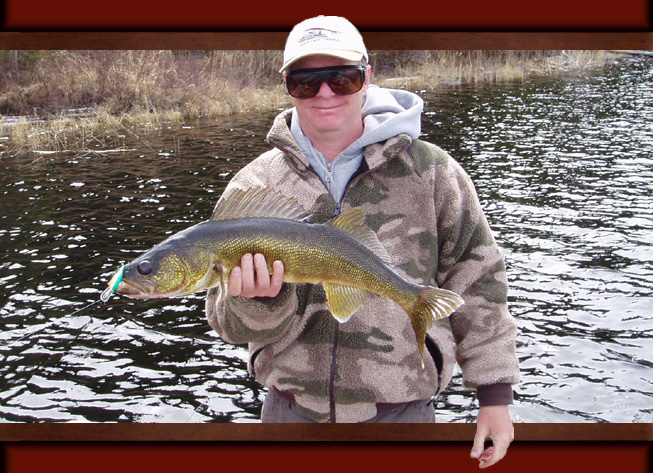
|
Prospecting for walleye with a tiny crankbait. The walleye above was taken in H-Bay in May of 2004 with the little #5 shad-rap on 6 lb. line (see the lure in his mouth?). The 19 lb. northern on the right was taken just a couple of minutes earlier on the same bait (thatís the same lure in his mouth).
First catch, looking for concentrated fish. The first walleye catch teaches us much. There will be three possible outcomes. First, it might be an isolated catch, and may not lead to paydirt. Second, it might be an indicator of a concentration of fish around some feature. Third, it may be an indicator of a large area of scattered fish. Our general goal now is to discover if the fish are concentrated or scattered. This will tell us whether we want to jig or troll. Did it come off the catch line or on the catch line? Was there a weedbed? Is there a shoreline feature such as a point or inlet? Is there an underwater feature detectable on the sonar? After establishing the most likely feature that might impact the fishing, we continue trolling. If we were nearing a point, we will bear down on it and spend a fair amount of time approaching it from different directions and moving in, out and around it; same thing for a weedbed or rock outcropping. We are searching for the spot on the spot (a term popularized by the In-Fisherman people). It might be the 5-7 foot catch-line along a particular shoreline. It might be the windy side of a point. It might be a group of small weed patches. The spot on the spot will have more fish than the surrounding areas. It will typically be a concentration of fish around a feature.
When we do find such a concentration, we will try to find the center of the concentration and park on it. We will probably be throwing jigs. If we are lucky, we will find a nice spot on shore to park our boat and fish from. More likely, we will float offshore and cast towards the spot. There is no more critical thing for exciting walleye fishing than finding the spot on the spot!
Scattered fish. As much fun as concentrated fish are, scattered fish can be as enjoyable. The key to catching scattered fish is to troll, and present your lures over a large area as fast as possible. Alternatively, if the wind is right, we may choose to hop a jig behind the boat as we drift across the bay. An example of scattered fish is the situation where the 5-6 foot depth is where the fish want to be, and a large expanse of the bay is 5-6 feet deep. The best example of this might be on Poplar bay. In the spring, about 50% of this bay probably bottoms out at 5-6 feet, and most of this region is filled with newly emerging weeds. On days when the wind is light, or very cold days when the shallows are cold, all of the fish in the bay may be scattered all about the bay. So what? It is possible to have a 100 fish day anyway, while trolling with appropriately chosen baits. The reason is that there are so many fish spread over a relatively small bay.
The secret to catching so many fish under these conditions is to keep the lure in the water as much as possible. That means getting it into the fish zone while avoiding getting tangled in the weeds. If the fish are active, you can pull a Rapala above the weedtops and entice them up. If they are less active, a jig and grub, or nightcrawler harness or other contrivance dragged on the bottom might be the key. All of the above indicates that we donít care what the quality of the fish is. We are just looking for fish. The next question is, what is our goal from here, quality or quantity? Sometimes we like to see if we can catch a hundred fish, and sometimes we like to concentrate on catching a big one. When we are lucky, we get both in one spot, but we can create our own future by taking the information we have learned from the day so far, and applying it towards finding the big female sows who must be somewhere in the water around us.
FISHING SKILLS! Hand-landing fish.
If you want to have a 100 fish day while trolling, give your net a rest. When using a crankbait with treble hooks, you will spend more time untangling the net than you will catching fish. It is extremely easy to hand-land a walleye, even when there are treble hooks dangling out, and regardless of size. Simply reach under the fish, and lift him out by the belly. He will not flop or squirm, and will hold still through the whole hook removal process. This is a dead easy technique and will at least double the number of fish you land while trolling. While this technique is most effective for crankbaiting, I use it exclusively when walleye fishing no matter what bait I use. It is faster, easier, and causes less damage to released fish. By the way, I hand-land virtually all northern pike as well, although the above technique does not work with northern, and could be dangerous!
|
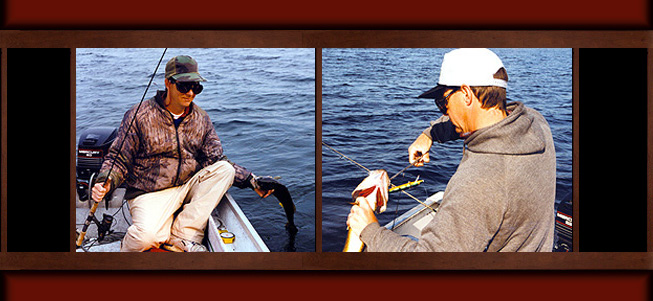
|
Belly landing. Instead of reaching under the fish with a net, I do so with my hand. Once I begin to lift, the walleye freezes and does not squirm or thrash around. Once belly- landed (left), the fish can be handled easily. Even with this big Rapala in his mouth (center), it is easy to handle the fish, even inverting it to remove the lure. As long as the fishermanís hand is on the belly, the fish will stay frozen, usually with its mouth open and gills distended. This makes for an easy picture as demonstrated here, and makes it easy to get the fish on a stringer or (preferably) release it because this 5 lb. breeding female is not an eater, it ought to go back into the lake to make more walleyes.
Warning: Hand-landing walleyes is hard on the hands. You will get nicks and cuts but you have plenty of time to recuperate after you get back home.
Finding bigger fish. When there are small fish in the school, they are quicker more numerous, and thus more likely to hit your bait than the big fish. Therefore, the chances of catching big fish are reduced when there are small fish around. The secret to consistent catches of big fish is to find schools that consist mainly of big fish. Schools of big fish can be found anywhere, but there is a consistent trend that can be used to locate them. In areas with large numbers of small walleyes, the big ones will be found in greater numbers outside the school of small fish and closer to deep water. This is not a hard and fast rule, but it is often true. So to improve your chances of catching big fish, find dense schools of small fish and work your way towards deeper water looking for bigger fish. Not just any deep water will do, though.
The concept of the catch line comes back into play here. It is not usually fruitful, as I mentioned earlier, to move out into the bay beyond the catch line. That is, into the flat bottomed gradually sloping bowl-like part of the bay. The water is cold and there is little food out there. Remember, the walleyes hang out at the catch line because the shallows are warm and they want to get as close to the warm water as possible. The warm water is the source of bourgeoning populations of minnows and leaches that serve as food for the walleyes. It is my belief that the larger walleyes move to deeper water to optimize their chances for getting food, since it is hard for them to compete with the smaller walleyes in the shallows. So, they move to the second most abundant source of food. To find it, they move on "structure" that leads to rocky points. Just as the weeds in the shallows harbor food, so do the rocky points. The crevices in the rocks allow abundant hiding places for baitfish and crayfish. More importantly, the rocky points and coves serve as ambush spots for walleyes to attack schools of baitfish. They donít do this consciously; of course, they are not smart enough to think about such things. Their instinct causes them to chase the baitfish, which rush away in panic only to run into the ridge of rocks on the point. I have often observed walleyes swimming in and out of small cove-like rocky cover as shallow as 3 feet. Moving closer to these areas one can invariably observe minnows and perch among the rocks. In fact, seeing these baitfish in abundance in the shallow water around the point is almost a sure indicator that walleyes will be nearby. If I canít see such indicators, I donĎt spend much time on the point.
The rocky points serve as a secondary feeding area. There may be less food here but it is usually larger and more suited for a big walleye. This movement of large walleyes will eventually be followed by the smaller walleyes as the water warms up. Eventually, the bulk of the whole walleye population will be found out in the main lake. The best routes to check are those that lead out into the open lake. Note that several shallow water bays in Trout lake are really like small lakes themselves. Keesic Bay and Long Channel are the best examples of this. They both have bays within the bay, rocky points within the bay, and more rocky points extending out into the main lake. As spring progresses into summer, the whole walleye population will make itís way along migratory pathways into the main lake. This migration is not continuous. It is punctuated. In other words, the fish move quickly between points, bars and islands, so they wonít be found in high concentration in-between the features. Once they encounter a feature, they will congregate there in large numbers, feeding and only moving as the temperature out deeper warms up.
It is important to recognize that even though the fish may be moving towards deeper water in the later spring, they will still be found mainly in shallow areas. Until the water temperature on the main lake is above 60įF for a number of days, it is usually a complete waste of time to fish for walleyes deeper than 15 feet!
BAYS OF TROUT LAKE
Protected Bays. There are two major categories of protected bays in Trout Lake, but they all have one thing in common; large areas of flat, silty bottom, dark water, and great expanses of weeds. The first category is the "shallow bay." The shallow bays are composed mostly of a flat bottom that gradually slopes from shore to a depth of several feet. Examples are Poplar Bay, Johnsonís Bay, and H-Bay. The second category is the "deep" protected bay. The deep bays are much more complex than the shallow bays. They do have areas of shallow water identical to that of the shallow bays, but they have a much more diverse structure. They are larger, have greater depth, and have many shoreline features such as rocks, points, and bays of their own. The most popular examples of deep bays in Trout Lake are Keesic Bay and Long Channel.
I will discuss one of each type of these bays below. I have included charts that illustrate some of the particular features of the bays, illustrating some of the better catch lines, and migratory routes from the bay. I caution the reader to realize two things. First, that no matter what anyone tells you, there is no such thing as a day when the "fish are not in [fill in the blank] Bay." They are there if it is spring and the Bay water is warmer than the lake water. It is a matter of finding and catching them. My wife Diane and I make a point of going to those very bays that have been declared fishless, because we will have less of a crowd to deal with and still catch plenty of fish if we are lucky. If you believe the first point, it makes the second one easier. Unless you are lucky enough to find someone catching fish in a spot, you will have to find them yourself. And you will have to re-find them from day to day. Finding fish on your own becomes addictive. Each time you do it you get a little better (it is not like golf, where you get a little worse each time you play). For me, finding fish is as satisfying as catching them.
Examples of a shallow and deep protected bays.
Poplar Bay. Letís first explore the easiest bay on the lake to fish, and an example of a shallow protected bay. Poplar Bay is often called "Popular" Bay because it is often crowded with boats. The reason is that most of the bay is composed of ideal habitat for spring walleyes. The entire center of this bowl shaped bay is no more than 6 feet deep most years. And all of that area is filled with weeds. Good luck can be had by just randomly trolling around the bay or floating with the wind. Because the bay is so small, it is easy to "happen" upon some fish. Now, these fish are probably relating to some pattern of wind and temperature, but you donít have to know that to find them, because there are so many fish in such a small space. Of course, if you pay close attention to wind and temperature as outlined above, you will find the fish faster.
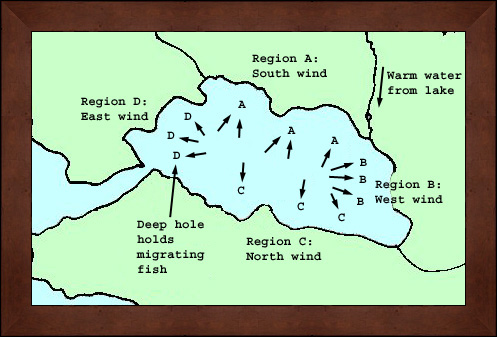
Area A runs along the north shore to a small creek that enters the bay on the northeast end. This entire shoreline can be very good up to the catch line when the wind blows from the south. This shore has some spots where the shore is rather steep and drops to 3 feet deep very quickly. In very windy conditions, the catch line can extend all the way to shore. My friend Paul and I caught over 100 walleyes along this shore one windy day. Many of the fish came from within ten feet of shore. These fish would never be caught trolling! They must be cast to like you would a bass along a shoreline in Texas. The creek may be a source of warm water due to a shallow lake that feeds it inland. However, the outflow from the creek is much lower than that from Brathurst creek in Keesic bay, so it does not dominate the nature of the bay as does Brathurst. Still, donít overlook the possibility, especially on calm days, that walleyes may be piled up near the creek mouth.
Area B becomes very shallow. When the wind is from the west, walleyes may tend to migrate in that direction due to the temperature gradient. Most likely, the catch line will be deeper than 4 feet. However, at times, fish may be found as shallow as 2-3 feet. This is true of all the shorelines and all the bays. It depends on turbidity of the water and temperature. Area C is a potential big fish spot. Along the more eastern part of the shore, the water is deeper than any other part of the bay except the mouth. There is a long trench of water 9-12 feet deep or more right next to the shore. On a day when the wind blows to this shore it simply must be checked. Throw a jig right up against the bank and let it drop into the trench. Work your way out from there towards the shallower water away from shore. Make sure you check the entire trench area of deep water that spreads out towards the north as you go away from the shore. We had fun there one day with about 10 other Booiís boats circling a small area and catching very large walleyes.
Region D, at the west end of Poplar Bay is the most interesting region. There is a very deep channel entering the bay. There is often strong current here, which seems to have carved a deep area that spreads out to the north from the channel. At any time, under any wind conditions, migratory walleyes can be found around this deep water. There are small bays on both sides of the inside of the channel. Walleyes can be caught in as little as 3 feet of water as they feed up into these bays. Fish all the way out to the deep water. More to the north, there are deeper weed flats than in area 1. These flats can be fished with the same techniques used for area 1. This is a staging area for the lead fish making their way out into the bay. Expect considerably more big fish here than in other areas of the bay. This region is best when there is an east wind, but can be productive at all times due to the depth and current. I have used Poplar Bay as an example here, but the principles apply to all the other shallow bays in the Trout Lake chain.
Keesic Bay. This is a delightful deep protected bay to fish in the spring. The conditions of the bay are strongly dominated by one of the largest creeks on Trout lake, which has strong current flow and is warmed by Rice Lake to the east. The current flows out parallel with the east shore (blue arrows) and influences conditions all the way to and past the little island to the north (I call it Hillbilly Island).
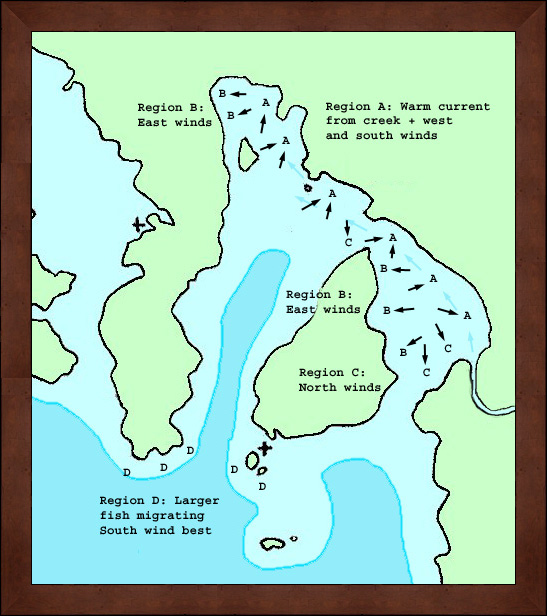
The vast majority of the fish in Keesic Bay are caught in the basin on the East side (Mary Deeís Nest), and along the Northeast and North shores depending on temperature and wind (as indicated by the arrows on the map). On occasion, sustained cold front conditions may push fish into the deeper water on the west side of Winkel Island. Migrating fish can be found at the rocky points at the entrance of the Bay (Region D). Fishing may be improved in this region by South winds. I have used Keesic Bay as an example here, but the principles apply to all the other deep bays in the Trout Lake chain.
Conclusions. With the examples of Poplar Bay and Keesic Bay described above, it ought to be possible to assess all the other protected bays in the Trout Lake System, from Moose to Jackfish on Trout Lake to Pike Bay in Little Trout Lake, and quickly find fish based on an understanding of the temperature profile of the bay. In spring, the protected bays of Trout Lake contain an astonishing number of walleyes. By adhering to a few simple rules, anyone can enter one of these bays even under the worst conditions (32įF water with ice floating at the mouth of the bay, as we experienced in 2004), and catch a boatload of beautiful walleyes. There are 3 main metrics to keep in mind for spring walleye fishing:
1) Temperature
2) Temperature
3) Temperature
The most important factors affecting temperature are sunlight, current, and wind. Under most conditions, the wind wins. Notice that I donít talk much about why temperature matters. There are a lot of theories and speculation about that, but thatís a matter for scientists, not fishermen. What counts is that the fish are controlled by temperature, not why. Carry a thermometer with you and you will not have difficulty finding fish in Trout Lakeís protected bays. Good Luck.
Copyright, 2004, James H. Brauker.
|
Go to top of page
|




